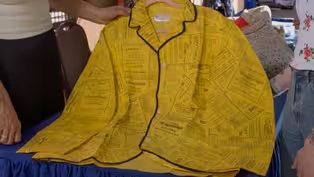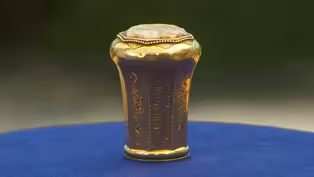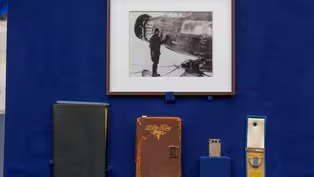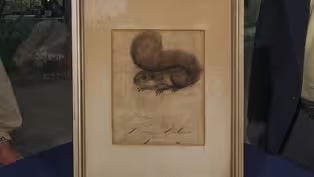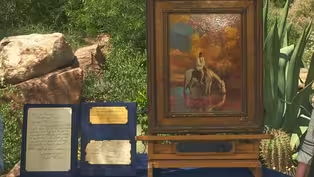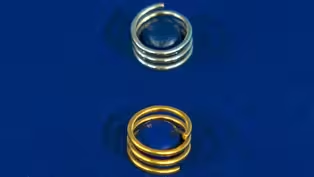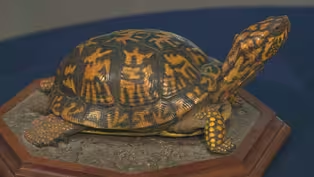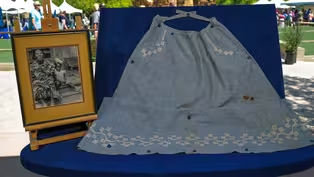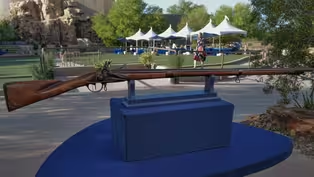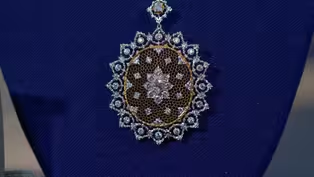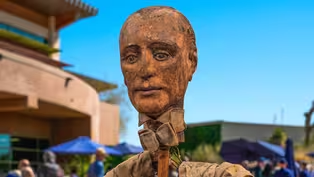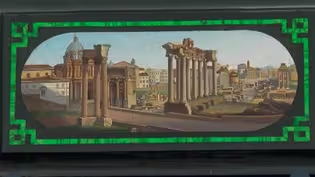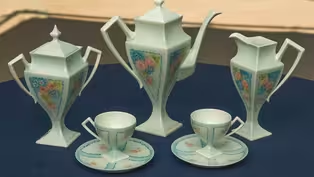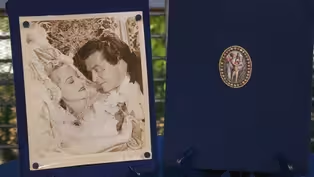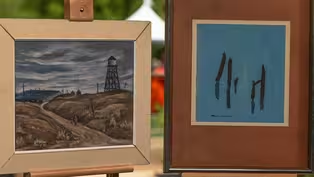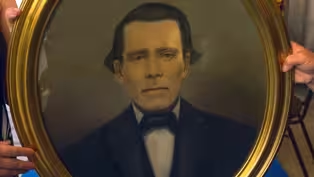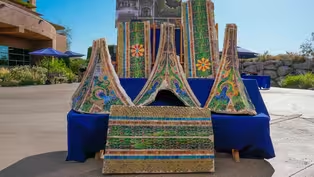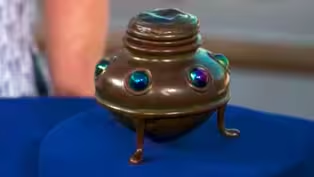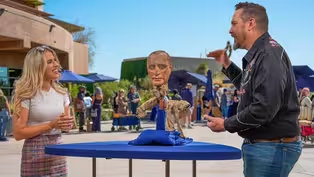
Springs Preserve, Hour 2
Season 29 Episode 5 | 52m 24sVideo has Closed Captions
Head to desert oasis Springs Preserve for treasures that are sure to heat up the market.
Head to desert oasis Springs Preserve for treasures that are sure to heat up the market, including a Harry Kellar illusion head, a Dinh Van-designed Cartier gold ring and Tiffany glass mosaics. Which treasure is the episode's top find?
Problems playing video? | Closed Captioning Feedback
Problems playing video? | Closed Captioning Feedback
Funding for ANTIQUES ROADSHOW is provided by Ancestry and American Cruise Lines. Additional funding is provided by public television viewers.

Springs Preserve, Hour 2
Season 29 Episode 5 | 52m 24sVideo has Closed Captions
Head to desert oasis Springs Preserve for treasures that are sure to heat up the market, including a Harry Kellar illusion head, a Dinh Van-designed Cartier gold ring and Tiffany glass mosaics. Which treasure is the episode's top find?
Problems playing video? | Closed Captioning Feedback
How to Watch Antiques Roadshow
Antiques Roadshow is available to stream on pbs.org and the free PBS App, available on iPhone, Apple TV, Android TV, Android smartphones, Amazon Fire TV, Amazon Fire Tablet, Roku, Samsung Smart TV, and Vizio.
Buy Now
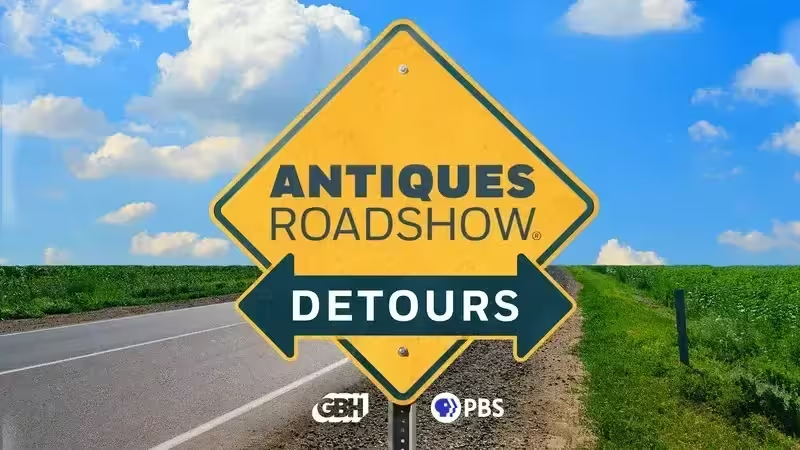
ANTIQUES ROADSHOW DETOURS
Ever wondered what happens to the treasures featured on America’s beloved ANTIQUES ROADSHOW after the cameras leave town? Host Adam Monahan tracks down the juicy afterlives of your favorite finds from PBS’s hit series.Providing Support for PBS.org
Learn Moreabout PBS online sponsorship♪ ♪ CORAL PEÑA: The treasures coming in to "Antiques Roadshow" at Springs Preserve in Las Vegas are real showstoppers.
GUEST: We kind of think that it could be a spirit cabinet-type thing.
Mm-hmm.
Where the face will, like, float around.
I just got the chills.
♪ ♪ PEÑA: Springs Preserve is a desert oasis for our "Roadshow" event today.
Las Vegas is in the Mojave Desert, and more than a century ago, people who lived in and traveled through this area could find refuge at seasonal springs.
Though the springs are now only underground, part of the property has been brought back to how it used to be, with cottonwood trees and two ponds.
Many of our guests have brought treasures that bring back the past-- take a look.
This is, I believe, a 1960s paper suit jacket.
We found it in an attic folded up in a plastic bag, and I don't think it's ever even been worn.
We paid $15 for it, which might be a lot for a piece of paper, but we think it was worth it.
I would date this circa 1965.
It is paper, based on the yellow pages.
This says it's from "Waste Basket Boutique of Mars of Asheville-- do not wash." (guest laughs) There you go, that, that, right there, don't wash it.
They were meant to be worn once or twice and disposable.
We normally see these in dresses.
It's, like, suit jacket, or like a pajama jacket, really.
I think if you were going to buy this, you'd have to pay about $375 for it.
Wow!
For a piece of paper!
Whoa!
Well, yeah, it's cool.
GUEST: I brought in a ring that I found at an estate sale a couple of months ago.
It was a dark room, it was a junk jewelry bin, and it had a five-dollar price tag.
And I just thought it was cool, so I picked it up.
When I got to better lighting, I saw little markings.
So I investigated a little bit further, and it kind of piqued my interest even more from what I saw.
What'd you see?
The 18 karats was what I saw first.
And then I saw the Cartier name.
Ah.
And then also another name which seemed Vietnamese.
Yeah.
I looked it up a little bit, and it seems like they were a designer for Cartier for a certain time.
Well, you're absolutely correct.
It is by a designer named Dinh Van, who worked for Cartier in the 1950s.
And he opened his own shop in 1965.
And he made very unusual rings, especially for a traditional jeweler like Cartier.
Just some funky shapes.
Mm-hmm.
Now, you also told me something special about this ring.
That it comes apart-- it comes into two pieces.
Yep!
That's amazing.
(laughs) That is so great.
I loved it, and...
I'm glad you think it's as cool as I do!
(laughs) 'Cause it's three rings in one.
Yeah.
We have the 18-karat white gold portion of the ring on top and the 18-karat yellow gold on the bottom.
On the yellow gold ring, it is stamped on the side "Cartier 18k Dinh Van."
My guess would be that these are from the late '50s, maybe early '60s.
I was looking up for similar rings from Dinh Van for Cartier, and I found other rings like this, but not the exact same thing.
And those were selling, at retail, for $6,000 to $8,000.
Oh, wow.
I would definitely put that ring in with that group, because it is so unique and so different.
That's quite the five-dollar find!
(laughs): Yeah, you can't beat that.
That's pretty good return.
I'd never seen anything like that, that unscrews, and I've seen quite a few bits of jewelry in my day.
Oh, that's so cool-- that's cool to know.
My father went for a trip to Russia against my mother's wishes.
Oh, my!
And he went to a place where they had local artists.
He wanted to show my mother the beauty of Russia when he came back.
But she always hated the picture, because she didn't like that he was gone for two weeks.
So what, was it in the closet or something?
No, it actually-- she did hang it up in the living room, but it was in a corner that nobody saw.
Begrudgingly hung it in... (laughs) Yes, yes, she did.
Yes, she did.
Okay!
This is a Roy Lichtenstein gallery print for one of his shows in New York City.
And it was signed by the artist himself, with the inscription.
To who, I don't know.
I found it at the Golden West Swap Meet in Huntington Beach, California.
I paid $60.
So, I'm hoping for more than that.
Tell me what you brought in today.
A flintlock musket that's, was supposedly used in the Revolutionary War, that Ben Franklin made some deal with the French.
I was in the Navy, and it was right around when the shah was in trouble, and we floated around in the Indian Ocean with a thousand Marines on our ship, ready for 'em to go ashore in Iran.
They were willing to give me a lot of their money playing poker.
(chuckles) So when I hit San Diego, I had money burning a hole in my pocket.
So I went up to L.A. to my parents', and then we went to this estate sale that a friend of ours was having.
He said he wouldn't take a penny less than what he paid for it, and he paid $75 for it.
Nice.
So I had to give him $75.
I've had it since '75, when, uh, I got back.
So what we have here is a French model 1763-'66 musket.
These would have been made from 1763 and then altered.
Um, the butts were shaved down a little bit.
They added some springs to the bands, thinned out the stock a little bit.
This one could have been made from anywhere between 1766 and early 1770s.
By the outbreak of the American Revolution, we were in dire need of firearms.
There was an embargo on arms from England.
We couldn't get any here.
And we were using old surplus arms, guns built from all sorts of different parts, and basically trying to cobble things together to function.
Benjamin Franklin, amongst others in the Continental government, as well as states, were trying to bargain with, with French suppliers to get some of the arms out of their arsenals.
In March of 1777, a ship arrived in Portsmouth, New Hampshire, called the Mercury.
And on board that ship were 11,987 of these muskets.
On the left side of the breach is the important part of this gun, and it's marked "NH2B," and then "NO," and a three-digit number that's been defaced, but that stands for New Hampshire 2nd Battalion.
They're very light, so they're hard to see.
We know that they took 2,000 of these guns from that shipment.
This is one of the guns that were shipped to Fort Ticonderoga and Mount Independence, and were issued out to the New Hampshire troops who later carried these at the Battle of Monmouth.
They were at Valley Forge and at Yorktown.
So it's got a great, great history.
The barrel length is 44 and three-eighths inches.
Flintlock, as you mentioned, would fire about a .63, .64 musket ball.
The other reason why they wanted these guns is to get as many troops as possible that were firing the same caliber musket ball.
Because prior to this time, there were so many different guns, that they had to supply ammunition for all these different arms.
There were other shipments that came in, so there was a lot of these guns that came in through Portsmouth, Boston, other states.
We don't know exactly the number, but it could be into the hundreds of thousands.
It's in overall untouched condition.
The only thing that's wrong with this gun is, it's got the incorrect ramrod.
Those you could get for probably $100, $150.
This type of a gun, without that marking, in this condition, are in the $2,500-$3,000 range.
That marking makes all the difference.
I would say at auction, I would put this gun, a conservative $10,000 to $15,000.
(inhales deeply): Ooh.
Now, I think of the things I could buy with that.
Yeah.
You certainly made some money on that one.
Yeah, for $75, if I'd put it in the bank, I don't think I would have made that much.
PEÑA: "Roadshow" doesn't appraise fossils, but one at the Nevada State Museum at Springs Preserve is worth a closer look.
Las Vegas is a desert playground now, but millions of years ago, Nevada was covered by an ocean.
This is the fossilized front flipper of an ichthyosaur, Shonisaurus popularis, a dolphin-like marine reptile that has been the official state fossil of Nevada since 1977.
GUEST: My father was in the relocation camps in Hunt, Idaho, called Minidoka during World War II... APPRAISER: Okay.
...during the Japanese relocation with his family.
My great-uncle Paul, who later became a, uh, relatively famous Northwest artist, came and visited the camps and did a painting of my father and his little sister.
So your father was how old when he was in the camp in Idaho?
14-- they went into the relocation camp in late '42.
Did he ever tell you any anecdotes about his experience?
Well, you know, one thing is that they were only allowed to pack one bag.
My dad packed his bag full of spitballs.
(both laughing) 'Cause he thought he was the best spitball maker in Seattle, and he wanted to bring those spitballs to the camp.
Wow.
But, uh, I think it was a really mixed experience.
I mean, he was a Boy Scout and he followed the war and he knew all the old songs and he was a patriotic American.
He wanted the Americans to win, and later in life, he admitted, you know, it was hard for him.
He married a daughter of a four-star admiral.
He wound up joining the Central Intelligence Agency.
(chuckling): Okay.
And traveled all over the world with the U.S. government.
And both of these are, are by the same artist, Paul Horiuchi.
Exactly.
So the one here, I'm seeing an oil on canvas.
So that's when he would have visited this camp.
Okay.
Yeah, he wasn't interned because he wasn't in the, on the West Coast.
You said that you met Horiuchi.
I met him at least twice, probably more.
The two I remember is, as a small child, let's say five or six years old, going to his studio in Seattle.
It's a kid memory, so I just remember these big beautiful things, these abstract things.
It seemed like the coolest place on Earth.
(both laugh) And he was the coolest guy on Earth.
Paul Horiuchi, he lived a remarkable life.
He did.
Horiuchi was born in 1906 in Japan.
Mm-hmm.
His father left for the States when he was just a few days old.
And then he later joined them in Rock Springs, Wyoming... Ah.
...where they worked for Union Pacific Railroad.
See, I didn't even know that.
His father, uh, ended up passing away at a relatively young age.
Uh-huh.
And Horiuchi, you know, he, his life, his early life was filled with a great deal of hardship.
Yes.
He worked for the railroad, making ends meet, and really only started to come into his own as an artist in the 1930s.
Right.
Where he had a few group shows.
When World War II hit, of course, it was a difficult time.
Yeah.
He lost his job at the railroad, ended up taking a car repair job, I think...
Yes.
...in the...
I remember that.
...in the, toward the end of the war.
Right.
And, you know, his work was really on pause at that point.
He was nearly 40 years old, and he, he was really just trying to raise his family and keep employment.
Mm-hmm.
He had a solo show at the Seattle Art Museum in 1958.
There are anecdotes of his shows selling out prior to the opening.
Wow.
He was best known for his collage work, which is the example closest to you.
It's a combination of gouache, like, a heavier watercolor, and then little bits of paper that are applied in those posts.
And I know there's an inscription to your family from when it was done... Yeah.
...in the 1970s.
Right.
His most famous work is a large mural at the Seattle amphitheater.
Yeah, Seattle Center.
Um, and it's still there.
Right by the, uh, tower, yes.
The example here, when he visited Idaho, is not what he's known for.
Right.
It's an early work, and as a result, doesn't have a great deal of value.
Certainly sentimental value to your family.
Yeah.
(laughs) Yeah.
I would put an auction value at $500 to $700.
Wow.
The good news about the collage is, it is exactly in that mature, prime period of Horiuchi's work, and it is today the most desirable style.
If I were to place an auction estimate on it, I would estimate it in the range of $6,000 to $8,000.
Oh.
Wow.
Wow.
It's beautiful.
I think so, too.
It's a really nice example.
Thank you-- thank you.
(chuckling) GUEST: My husband purchased this sometime in the '60s in Philadelphia.
Okay.
We've always wondered about it.
We love the look of it.
The markings are Tiffany.
So what we have here is a Tiffany Studios turtle-back jeweled bronze inkstand.
It's got this wonderful bronze with this greenish patina to it that it developed over time.
And you've got this wonderful turtle top with the iridescent glass.
You have the original glass liner, which is great.
So often these t, these things get broken over time.
Mm-hmm.
Now, there's actually three parts.
See, this actually shouldn't come out.
Okay.
And it has a little solder mark at the base.
Oh, okay.
It is a little bit of a condition issue.
And I would advise that you get that resoldered into, um, the base of it so that it sits still there.
And now let's look at the mark.
You've got that "Tiffany Studios New York" mark on the base.
It's dead center.
But what's interesting about this piece is, there's no number.
Usually, you have a, a number stamped into it under the "Tiffany Studios," which leads me to believe that this is an early piece.
And Tiffany Studios produced their catalogue in 1906.
Uh, so I think that this dates somewhere between 1902 and 1905, because there is no number on there.
But the great thing is, all of these jewels are original to it, as is the lid.
A wonderful object, with its original liner.
It is worth, in today's marketplace at auction, $3,000 to $5,000.
Oh, wow, very good.
(laughing) That's good to know.
How did you get this book?
My father would skip school and hang out by Yankee Stadium.
He met all these players and they signed them.
For collectors, they love anything that has Ruth and Gehrig together.
So I would value this page $3,000 to $4,000.
Wow, that's the best news-- thank you so much.
I'm a magician, and I'm really passionate about magic history... Mmm.
...in addition to performing and magic technique.
So sometimes, when antiques and magic collide... Mmm.
...that's really exciting to me.
Found this online, and basically, a antique store in London that didn't specialize in magic... Mmm.
...but just, like, high-end antiques, they had this head.
They acquired it from an artist who acquired it in New York in about the '60s.
And they bought it with the understanding that it had belonged to Houdini and it was used in illusions.
Based on some research I've done... Mm-hmm.
...think it's, uh, actually Harry Kellar.
Mm-hmm.
Which is where Harry Houdini got his name, Harry.
Mm-hmm.
Because Harry Kellar was, like, the O.G.... Mm-hmm.
...magician and, like, an idol to Harry Houdini.
Yeah.
And Harry Kellar had actually gifted Houdini his props and things like that towards the end of his life.
So logistically, that would match up.
It's made from hardwood.
Yeah.
It's very well-carved.
You look at pictures and posters of Harry Kellar, and there's a pretty astonishing resemblance.
I'm right there with you, I believe it is Harry Kellar.
Harry Kellar is known as the dean of American magicians.
He was born in 1849, and had kind of an odd career beforehand.
Had a couple of false starts as a performer.
And his career really hit it big in the 1880s.
He quickly, over the course of a 40-odd-year career, became one of the most important American magicians, period.
Previously, a lot of magicians relied on vaudevillian sleight of hand, quick stage acts that you could perform anywhere.
He really mastered the art of larger stage shows.
Yeah, for sure.
Uh, performing for, i, in Brazil and South America and all over the world.
And what he did is, he relied more, not so much on sleight of hand, but more of larger illusions and mechanical tricks and devices to help him do his performances.
And in the magic world, those props are custom-made.
Yeah.
They can be unique to the ideas and the techniques that magician uses.
And those secrets are held very, very closely.
They don't often enter the open market.
A lot of these stage illusions, especially, are going to be traded behind the scenes.
With regards to Harry Kellar, he retired in 1908.
He was good friends with Houdini later in life, and, yeah, a lot of his stuff went to Harry Houdini, but this never really shows up anywhere.
I'm not able to find any idea of what kind of trick it was used for.
At a guess, is, my thought, it was probably used for a spiritualism trick of some sort, a levitating head of some sort.
Do you have any idea how you might use it?
We kind of think that it could be a spirit-cabinet-type thing... Mm-hmm.
...where, like, the face will, like, float around... Mm-hmm.
...and, like, in this ethereal-type... Mm-hmm.
...ectoplasma or something.
Another interesting little tidbit about Harry Kellar is that all those props sank, uh, in a shipwreck.
Yeah.
So we know it's probably not from before that period-- it, it's gotta be later.
And this is an older man.
It's probably around 1900 or so.
In that era, a lot of magicians would build their own props, uh, their own illusions.
But this is a very, very skilled carving, and my suspicion is, he probably had it commissioned.
Do you remember what you paid for this?
Yeah-- total with shipping and everything... Mm-hmm.
...from Europe was about $5,000 U.S. Because of the scarcity of high-end magic props and effects entering the open market, I would not be comfortable putting an auction estimate on it, because we don't know what these trade privately for.
But I would have no problem putting an insurance estimate of $60,000 to $80,000 on it.
Oh, yeah... (chuckles) Wow.
Ha!
(laughing) And I'm sure that there are a few people who would probably pay much more.
But again, it's all a secret.
(snorts) Yeah, true.
Yeah, wow.
I've showed it to a few people.
Um, and they're definitely, uh, jelly for sure.
(laughs) But this is kind of my first time really displaying it openly.
Mm-hmm.
PEÑA: Desert creatures are a fascinating feature at Springs Preserve.
What I'm holding here is called a vinegarroon.
They're very solitary, they do live here in the Mojave Desert.
They have two glands at the base of this tail.
And their defense mechanism is to spray acetic acid in the nose and eyes of any potential predators.
So acetic acid is basically vinegar.
So they get their name because they smell like vinegar.
She is part of the arachnid family.
Another name for them is called a whip scorpion.
So you see this long tail here at the back.
They try to trick predators.
So if the vinegar smell doesn't scare you away, then the potential to maybe get stung might.
(chuckles) GUEST: Well, this is actually a wood carving.
And it was carved and painted by my older brother, who is no longer with us.
But, uh, he was a tremendous naturalist and a wonderful artist.
And his name was... Doug Eppes.
And this is him.
Mm-hmm, this is him, that's my brother.
When did he make it?
Between mid-'80s, uh, up to '90.
He died very young, 41.
He did.
As a child, he had hepatitis, which weakened his liver.
And then I have to say that 20 years of substance abuse finished him off.
And, and you were telling me that he would trade his carvings in bars for drinks.
As a person that's an alcoholic, you will get to the point where you will trade something like that for a drink.
Fortunately, he did it at a local watering hole, and the bartenders would see to it that it got back to the family.
So let's start with where he lived.
In Newark, Delaware.
And he learned the craft of wood carving with waterfowl.
His mentor was Bill Veasey, who's a very well-known carver.
My brother decided to do something that was his signature thing, and that's what this turtle is.
And this, of course, is an eastern box turtle, the, the m, the most common woodland turtle in the, in the Eastern United States.
When I look at this, I'm just astonished by the realism of it.
Everything about this says that this turtle is alive.
(chuckles) But it's not-- it's a carved piece of wood, carved and painted.
Basswood is what he used.
The individual little scutes on a turtle shell, he's got the growth rings or the growth lines carved into there.
His little plates on his feet, where he's protecting himself when he's digging, are perfect.
And I've got to believe, had your brother lived longer and established himself, that he would be recognized as one of the great wildlife woodcarvers.
Thank you for saying that, I really appreciate it.
(chuckles) The only one that I know of that has ever been sold sold for $3,000.
A turtle.
A turtle.
The three of us at the folk art table sort of polled each other, and we all came up with an auction estimate of $2,500 to $3,500, so... (laughs) (laughing) There you go.
Yeah, yeah.
So... You guys are pretty good.
(both laugh) GUEST: I picked it up at an auction.
I collect Civil War stuff, and it was dated 1862.
And I thought it was a beautiful piece of art.
And so what is it?
I believe it's a personal seal from a, a man in California.
It did not start out life as a personal seal.
It's a cane topper; it's presentational.
And when it was presented, somebody chose to present it as a personal seal so it could be on their desk.
It's gold-plated, also known as rolled gold.
The piece is inscribed on various panels, and it's inscribed "G.M.
Burke, County Recorder of San Francisco, by his friends."
And then it has five initials, and then it's dated April 1861.
And you can see that all around the exterior.
The piece has the initials of the recipient on the underside.
And we can see them right there.
That's not the most interesting piece on this.
What is the most interesting piece is the top of it.
Okay.
And do you know what's the top, in the top of it?
Uh, it's got gold flakes, I can see that.
Sure-- so it's actually gold quartz.
It's a quartz which has gold flakes naturally set into it.
Gold quartz was discovered in California in 1850, and it was very quickly employed into pieces such as this.
We see a lot of cane toppers on "Roadshow," and often, the individual that it's presented to is not really of any major historical significance.
And that's sort of the case with this piece.
But what is so unusual is the gold quartz.
In 2019, an identical cane, or cane topper, came up with a different inscription, and it sold for $2,250.
Wow, so...
So if I were to see this come up for auction today, I'd say somewhere between about $2,000 and $3,000.
Wow, well, thank you.
Thank you, appreciate it.
I bought it at a flea market in Minnesota 20 years ago, and I don't know much about it.
I paid $31.
PRODUCER: What, what is it?
It's a vase.
I just really like it.
And when you look at it different ways, the balls look like they're floating.
I think this is a mid-century modern chair.
I think it was made by some fancy guy in the '50s.
I really don't know his name.
My parents had it in their home for many years.
Then they moved out here, and I stole it from them.
I know my, my brother wants the chair, and I told him he can't have it, so...
This is my great-great-grandmother's apron.
My great-great-grandmother was freed from slavery when she was 12 years old, and the apron has been in the family ever since.
My mother gave it to me with no explanation.
My family was from Austin, Texas.
I don't know that that's where the great-great-grandmother was enslaved.
Because back in the day when I grew up, folks didn't talk.
And not only did they not talk, children were not encouraged to ask questions.
I do know that when Grandma, Great-Great-Grandma, the owner of the apron, did try to tell stories about her life on the plantation, family members said, "Oh, don't nobody want to hear about all that stuff."
Do you know your great-great-grandmother's name, or anything else?
I known, I, I've, I've told you what I know.
Oh.
But you've also brought this photo today.
My mother also gave me the photo, and that is Great-Great-Grandmother, and that is me when I was two years old.
So that makes it 85 years ago.
And I wasn't a nice little kid, because I was bothered a lot by old people.
(chuckles) Never realizing that I was going to be old one day.
So what year would this photo have been taken?
That would be 1939.
So your great-great-grandmother would have been about your age, a l, a few years older, in this photo.
Uh-huh.
Oh, I hadn't thought of it that way, thanks.
Yeah.
(both laughing) What an amazing document.
Looking at the fabric, looking at the embroidery and the size of it-- we h, we see it a little folded here, but it's a bit longer-- those all tell us that your great-great-grandmother probably made and wore this a little bit later in life.
It is an adult woman's apron.
This is a very small patterned gingham cotton plain weave, and a fabric like that could have been produced anywhere from the mid-19th into the first two decades of the 20th century.
And the design itself of the, the pattern is actually an Indian design.
Ginghams like this, plaid gingham, came from Madras, India.
Oh, okay.
So in the, in the, uh, late 18th and early 19th centuries, and it was imported in huge quantities to America.
Mm-hmm.
And then Americans began weaving their own.
She took the time to embroider it all over the hem and the pockets with this amazing cross-stitch in cotton thread.
It has both machine stitching, but there's also evidence of hand stitching, in addition to the hand embroidery.
So it's possible that your great-great-grandmother bought the apron as it was and embroidered it or even bought it with embroidery.
But it's also entirely possible that she made the garment herself from fabric that she purchased.
The one element that kind of helps to date it as closely as I can are the pockets.
They're a really unusual shape.
You see these pockets in pattern books for aprons and pinafores around the year 1900.
It's a different kind of cotton than what you can get now, that's for sure, and you can feel it, the higher quality.
It was meant to last.
And it has definitely lasted.
What would you think this would be worth?
$300.
In a shop specializing in historical clothing, I might expect to see it for maybe $50, $75.
Aprons are not rare.
But with your family's history, with this photograph, I could easily see this selling in a retail setting for about ten times that.
Oh!
So probably somewhere in the range of $700 conservatively.
If a genealogist were to work on your family history, with a family tree, I could easily see even that figure doubling and probably going for as much as $1,500 to $2,000.
Well, I think I'll go genealogy route.
(laughs) I need to know more.
It's a prototype.
We have a patent for it from 1920-something or '30-something.
My grandfather had it.
And now it's ours.
And we're trying to figure out what it is and what's the history behind it.
This is by Laura Volkeringding.
She's primarily known as a photographer.
It's from 1970.
This is something that my parents gave me for my birthday.
Everyone in my family hates it, but I love it.
And I don't care if it's worth nothing.
I will still keep it above my desk in my office.
GUEST: I was shopping in Palm Springs, California, about 1996.
I saw it, and I noticed that it looked like a prop.
It's not fine jewelry, but it looks like a hand-painted watercolor in there.
The tag said that it was a piece of costume jewelry worn by Paulette Goddard in the movie "Kitty," 1945.
So that's what kind of drew me to it.
How much did you have to pay for it?
Uh, $75, I think it was.
So how long after did you find this photograph?
Well, as we had more access to the internet, I found there's quite a few of these publicity photos that you can see the brooch.
We can very clearly see here in the corner she's wearing it, and it's very easy to identify.
And of course, this is Paulette Goddard with Ray Milland from "Kitty," 1945, in the role of the kind of street urchin that they were trying to turn into a society lady.
Hm.
So they could marry her off to someone rich and help save their family's fortunes.
We do know who made this.
There's a man named Eugene Joseff.
And one of the signature hallmarks of Joseff of Hollywood is that he came up with something he called the Russian gold-plating technique, which is not Russian, and it's not gold.
Right.
But it sounds fancy.
You'll notice on the back, it's kind of a dull gold tone.
Right, it almost looked like spray paint.
He knew that with the studio lights, if you have highly reflective metals, they sometimes catch the light.
Ah.
So he used this dull plating process to avoid things flaring on the cameras.
The other thing that jumped out at me is, I noticed the scrawled numbers and letters on the back.
There are three digits and a, and a letter.
And I recognize that as how they kept their inventory for their stock at Joseff.
Ah-hah.
Because the brilliant thing about Eugene Joseff is that he didn't just make these things and sell them to the films, he rented them.
We have faux pearls surrounding this kind of base metal, and we have probably Austrian crystal with glass, and, of course, this watercolor piece underneath.
Mm-hmm.
We're not familiar with any other pieces in their archive that have a watercolor.
Right.
It's trying to look like painted porcelain, basically.
Yeah.
And it's a good fake, because, on camera, you'd never notice that this was a watercolor.
Right.
This piece was probably made sometime in 1943, 'cause filming wrapped on, on this movie in 1944.
Given the fact that you have this wonderful picture of her wearing it, I think at auction, it would be somewhere in the $2,000 to $3,000 range.
That surprises me.
Thank you, that's, that's more information than I ever imagined.
I brought in a couple of diaries from Elbert John Thawley, who was the second engineer on the supply ship for Admiral Byrd's expedition to Antarctica in 1928.
Plus, he also received a gift from Mrs. Byrd, Christmas of 1928.
And then this is his congressional medal that he was gifted at the end of the expedition.
I found these diaries during COVID, and I started reading them, and they were a little spicy.
And this gentleman is an ancestor of yours?
So that is my husband's grandfather.
The expedition leaves in October of 1928.
He is on the supply ship that is sort of making runs back and forth, right, from...
Yes.
...Antarctica to New Zealand.
Yes.
And he keeps two journals while on board.
And what's the difference in these two journals?
Well, it's my opinion that this journal is actually the one that he would show his mother.
(laughing): Okay.
(laughs): And then I thought, this one is, is a little more graphic and a little more spicy.
And, and longer and more detailed.
And longer.
Right?
And more detailed.
So, yes, maybe this is the official one.
Yes.
And then this is the dirt.
Yes.
The one with the real dirt.
Can you remember what some of the stories are that you uncovered?
A, a couple of stories.
One was a story where he had actually saved somebody who had fallen off the ice, and he had to kind of crawl out to the ledge as it was crumbling and pull this guy back up.
So that was actually in "National Geographic."
Other stories were about people getting drunk and jumping off the boat, and boats running aground and just mayhem.
One of my favorite pieces is this one.
It reads "Mrs. R.E.
Byrd, Christmas, 1928, Dunedin, New Zealand."
And on the other side, it's personalized, "To Elbert Thawley, member, Byrd Antarctic Expedition."
And then the last one is the congressional medal...
Yes.
...that was given to all the members of the expedition.
Yes.
There are only about 65 of those out in the world.
Polar exploration is really hot now.
Mm-hmm.
Admiral Byrd is one of the top...
Yes.
...people that you would pursue.
However, we also want other voices.
You said there's information in here that doesn't appear in the histories.
If we can shine the light on a story that hasn't been told yet, that's really terrific.
We'll start in the middle.
This one, the more mundane journal... Mm-hmm.
...it also isn't fully complete.
Yes.
I would say $1,000 to $2,000 auction value.
Okay.
But for the real one, with the dirt, I would estimate this at $5,000 to $7,000 for this one.
Wow, okay!
Wow!
The, going down to the congressional medal, those have sold at auction recently.
Okay.
And I would put an estimate on that one at $5,000 to $7,000, as well.
That's a great piece.
Wow!
The, the lighter, I think, is maybe your wild card piece.
Hmm.
It's the kind of thing I don't know that I would put a very expensive price on.
Yeah.
But it's such a fun, quirky piece, I would expect it might fly.
Okay.
So I would probably estimate it in the range of, like, $800 to $1,200.
Okay.
Wow, that's amazing.
I had no idea.
I don't know a, a whole bunch about...
I'm not, I'm a jazz, uh, player, so it doesn't apply to me.
It's classical.
It's a 1971 Yairi Gakki, and it's signed by, uh, Mr., uh, Gakki.
It's not my style, but it works when I play it.
(chuckles) Well, this statue was a gift to my great-grandfather from businessmen of Germany.
And I think this is most likely prior to World War I.
This is very similar to what was being made by lots of German factories, a kind of German Art Deco.
These very large, overscale, plain white figurines.
Insurance value probably in the $2,000 to $3,000 range.
It's a very impressive thing.
Beautiful.
GUEST: I got it from my father-in-law, who got it from his best friend that got it in Rome.
He was there for about a year making a movie in the '60s.
He was a screenwriter.
And so he brought this home.
And then I saw it at his house one day.
I'm, like, "Oh, my gosh, it's the most beautiful thing I've ever seen."
And so one day, my husband came home with it and said, "My dad said give you this," and so I was, like, "Oh!"
(laughs) So this is a Grand Tour souvenir from Rome in Italy, dating between 1860 and 1880.
And it's known as a micromosaic.
The art of micromosaic was very popular in the 14th century... Mmm.
...in modern-day Istanbul.
Oh!
They really developed the technique.
The center panel is comprised of small glass tesserae, tens of thousands of them, in colored glass.
(whispers): Wow!
Those are set within a piece of black slate.
And then that green bit, that is a piece of stone known as malachite.
So this is the scene of the Roman Forum... Mmm.
...which was the center of daily life in Rome at the period.
And these sort of archaeological ruins were among the most prized sites for visitors to see... Mm-hmm.
...particularly in the 18th and 19th centuries, when many aristocrats and young scholars were on what was called the Grand Tour through Europe.
Mm-hmm.
Specifically here in the Forum, we have a number of, of sites.
You have the Temple of Saturn in the center.
The pillars on the left depict the remnants of the Temple of Vespasian and Titus.
It's about ten by four inches, which, for a micromosaic, is a fairly large size.
Mm-hmm.
Many of these in the period were sold with frames.
Oh!
And I suspect originally this may have had a gilt wood frame.
Oh!
Oh, that would be pretty.
There were a number of workshops... Mm-hmm.
...that produced pieces like this.
One of the most notable is the Vatican workshop.
Oh!
In looking at the quality of the tesserae pieces here... Mm-hmm.
...the colors of the glass, the intricacy of the panel... Oh, I can't believe it's that... ...it's quite possible that this was done by the Vatican workshops.
Oh!
We would need to do some more research... Yeah.
...to confirm that.
Okay!
Were this to come up in a well-advertised auction, I would expect it to bring between $7,000 and $10,000.
Nice!
Nice!
Yeah, I love it.
(laughs) My father, at the age of five years old, went to the Chicago World's Fair in 1933.
They saw a crowd of people gathered around on a corner, and my father worked his way up to the front of the crowd and he saw the artist, Barney Nelson.
Barney had no arms, and Barney was creating the artwork with, using just his feet.
Mm.
Barney had announced to the crowd that, "The first person who could guess what I'm about to draw next will win the drawing."
And when he first began to sketch it, he started off with the tail.
And my father spoke up and said, "It's a squirrel."
Hm.
And my father won, won this beautiful drawing.
According to the 1910 census, Barney Nelson was born in Connecticut about 1879.
The census lists him as an African American, and his occupation is listed as crayon artist.
He was known during his career as the Armless Phenomenon.
He was born armless as a, as a result of a birth defect, and he built a career out of what he was able to do, and that is become a rather accomplished, uh, artist and performing at fairs and in front of crowds.
It is crayon on paper, it's an artist's crayon.
And as you can see, he made good use of shadows and textures.
And notice how really elegant the signature is.
It has a really nice, late-19th-century calligraphic style.
If this were to be presented in an auction format... Mm-hmm.
...a, a very reasonable auction estimate for it would be in the $1,500 to $2,500 range.
Okay.
And we all, we all agree it would not surprise us if it reached $3,000, or maybe even more.
Mm-hmm.
♪ ♪ PEÑA: As an environmental steward, Springs Preserve is working to bring back native species like the relict leopard frog.
We're out here at Cottonwood Grove.
This is one of the areas that we've done a lot of habitation and restoration work on.
And we've reintroduced several species.
We've brought back a species of leopard frog.
The frog population here has been incredibly successful.
We have large population numbers here, as well as some of the largest of the species ever recorded coming out of these habitat ponds.
GUEST: I have my grandmother's Buccellati necklace that she left to me 20 years ago.
She had told me about it for years.
It was her favorite possession that she owned.
And she was a very stylish lady, and she was very proud of this necklace.
And I have the original box here, which, I love that I have the original box.
I love that, too.
And it's got the little original pin to attach it to clothing.
Yep.
Buccellati is really known for gold workmanship, first and foremost, and textural design.
Mm-hmm.
They don't use a lot of diamonds.
My great-grandmother had a watch that, my grandmother used the diamonds from that watch, she wanted, I guess, incorporated into this piece.
Mm-hmm.
I have some paperwork, and it, it talks about this in the paperwork.
So these diamonds came from her watch, you think.
Some of them.
Okay.
They had to add diamonds, I think, too.
But we only have about four carats total of diamonds.
Okay.
So it's not that much in carat weight.
It was made in Italy.
And you have some documentation, um, talking about that?
I do-- they sent her a design and she approved it.
Mm-hmm.
And it was, this was all written correspondence.
This was the design they sent her, and she was very happy with it.
I think in the letter it shows that she paid approximately $2,100 for it...
Okay.
...in 1972.
It said that it took two months to make.
It is made out of 18-karat gold.
Mm-hmm.
It's white gold and yellow gold.
Okay.
And Buccellati is still well known for using white and yellow together.
Mm-hmm.
The firm was begun by Mario Buccellati in 1919.
This one is signed Gianmaria Buccellati, who was his son, and he took the firm over in 1966.
Gianmaria was really in charge of design more so than anything else.
Mm-hmm.
And he really wanted to focus on sort of a prettier look with the textured jewelry, textured gold, and this is sort of like a Venetian lace design.
It also turns into a brooch.
Yes.
Right?
And it can also be a solitaire necklace... Ah.
...if you unhook the pin from it.
Right.
And the clasp matches the necklace piece, as well.
Yeah.
I love that about it.
So, yeah, it's, it's a really kind of cool convertible.
Mm-hmm.
And it is signed "Gianmaria Buccellati" on the clasp.
Oh, it is?
Buccellati right now is known throughout the world, and they are just hugely popular.
Okay.
As an insurance value, I would say you're looking at $30,000.
No!
Yes.
I just got the chills.
Yeah, I would say so.
That much?
Yes.
Wow!
Thank you so much.
My pleasure.
I think this is the best day of Stella's dead life.
Aww.
(both laugh) I think she, this is her... May she rest in peace.
This is her favorite show.
Oh!
And I think she's just... Oh, if she could only be here and see this.
I think somewhere she's watching.
She's watching.
Yeah, yeah, I'm sure she is.
Yeah.
GUEST: I have a, uh, painting that was done in Taos, New Mexico, by Bert Phillips.
My grandmother bought this in the '30s.
She bought it directly from the artist.
And I have a thank you letter from the artist right here.
Well, it is a lovely example of a work by Bert Geer Phillips.
It's oil on board.
He's quite an interesting artist.
He's known for the Western subject matter, but he actually was an East Coast guy.
Really?
So, yeah, he was born in Hudson, New York, in 1868 and started drawing from a very young age, and won awards and really decided that art was gonna be his career.
Wow.
So he did study in New York at the Art Students League, and then eventually ended up in Paris, where he studied painting along with important artists like Joseph Henry Sharp and Ernest Blumenschein.
So when he got back to the States, he really had a desire to head out west.
So he and his friend Ernest Blumenschein planned a sketching trip, where they were gonna head out west and eventually end up in Mexico, or so they thought.
So they went out on their adventure and they only made it as far as Taos, because once they got there, I think they decided that was it for them.
That was it.
That was where they wanted to stay.
By 1898, I believe, Phillips had settled as a full-time resident in Taos.
Phillips was one of the first artists, actually the first artist, to move to Taos and was a founding member of that artist colony... Mm-hmm.
...and really devote the rest of his life to painting in that landscape, he was just so taken by it.
And that's what we see in his work.
He has a reverence for the subject.
He has a romanticism, and I think you can feel the emotion that he felt.
Absolutely.
And there really weren't any tourists or galleries in Taos at that point.
So the way that these artists became known was by kind of banding together and exhibiting their work in other cities.
Ah.
And then they became more well known, and then there was a real...
They created a real demand for the work.
And so the paintings were selling very quickly.
Which also leads me to think that he probably painted this some years before your grandmother purchased it.
Mm-hmm.
But probably wasn't sitting in the studio for all that long.
This is special not only because it's a lovely painting, but because of the unbroken chain of provenance, the fact that you have the letter that he wrote to your grandmother and even the original check where she paid him for the painting.
I would expect a price tag on this, for a retail value, which would be your insurance value in this case... Mm-hmm.
...of $35,000.
Okay.
Great!
$300 to $35,000.
Pretty good investment.
(both chuckle) Sure is.
♪ ♪ I found it in an attic in a house that I bought in North Dakota in the year 2000.
I was just digging around to see what I could find, and it's been moving from house to house with me ever since.
And what do you think it is?
I think it's a food ration from World War I or World War II.
It's not from World War I or World War II.
This came out in 1981.
This is a Cold War-era thing.
It's from the '80s to the early '90s.
This is MRE-- meal ready to eat.
These were surplus that you would buy in case there's an emergency and you needed food.
Now they've become popularized, and there is a whole group of people who collect them.
Not worth a ton of money-- retail about $30 today.
Okay.
But what did you pay?
Uh, nothing.
Nothing.
(laughs) So that sounds like a win to me.
Thank you.
Thank you very much.
Enjoy your...
Meal?
...um, ham and chicken loaf, if you dare.
I think I'll k, take you to my next house.
(chuckles) That's a good, that's a good thing.
GUEST: My big question is, is this a child's, like, tea set or, what was this used for?
I mean, I'm thinking it was a child's tea set 'cause it's so tiny.
But then, why would you give this to a child to play with?
My brother got it for me 14 years ago?
So I want to pass it down to my niece.
There are such things as child's sets.
Mm-hmm.
This is not a child's set.
Oh!
And by the way, it's not a tea set.
It's a coffee?
It's a coffee set.
Okay.
Coffee pots tend to be taller with a more extended spout.
Okay.
The porcelain was made in France.
Mm-hmm.
And Limoges.
And let's look at the b, bottom of one of these.
Mm-hmm.
They're all marked the same way.
Okay.
It says "Limoges France," Limoges being a town famous for making porcelain.
Okay.
For hundreds of years now.
The decoration on it... Mm.
...the painting, is American.
We see a lot of china-painted ware.
But this piece is exceptional.
Almost all that we see is, for want of a better word, kind of grandmotherly.
Right.
There's a lot of very old-fashioned floral painting.
This is painted, I believe, by a young, switched-on, kind of flapper woman who was in tune with the Art Deco taste of the day.
Right.
This is very, very modern.
Now, we're showing two, a pair of what I would call demitasse and saucers.
But I believe you have how many altogether?
Six.
I'm going to date the whole thing to about 1925, which are when I think the painting was done.
Okay.
You say your brother bought it for you?
My brother did, yes.
He lived in Denver and saw this in a, just a little antique store.
And how much did he pay for it in that antique shop, do you know?
$300, I think he said?
As far as the value, he paid a fair price for it back then.
But I think if it was in a good antique shop today, I could see it priced at twice that.
$500, $600, or even $700.
Oh, nice, nice, nice.
It, it is so pretty...
Yes.
...so exquisite, so delicate.
Yes, I love it.
It's just, it's so cute.
(laughs) Yeah, it's a treasure.
Yes, it is.
Tell me how you came to acquire these very large and heavy pieces.
We took possession of the Farwell Building in 2015, 100 years after it was built.
The three main lobby glass tile domes were Louis Tiffany.
They were in severe disrepair, they were not restorable.
So we ended up removing all those domes and rebuilding them completely.
Um, the building had been vacant for 35 years or so.
Um, lots of things were destroyed and stolen.
So we rebuilt the ceilings completely.
And these are the remnants of, of what was there.
Well, I can tell you that Tiffany was so proud of this that they even published an ad stating that they had just done the work in the Farwell Building.
So it, this was something that, uh, Tiffany wanted to advertise prominently.
And the building did open in March of 1915.
And Tiffany decorated the first-floor corridors with these wonderful barrel-vaulted ceilings with rib vaults.
These are the cornices that were beneath where the rib vaults started.
We're looking at these upside down, but if these were turned around, you can see these classical-designed vases holding these stylized curlicues and flowers in the middle here and leading up to the bottom of the festoons that continue into the rib vaults.
Most of the work was actually done at Tiffany's studios and then it was...
Shipped over.
Yes, which is quite remarkable.
What I love about these in particular is, with the Tiffany glass that you see, it's not just an opalescent or an opaque glass.
You also have some gold iridescent glass, and you even have some textured glass that you would see in some of the lamps, which is unusual for a mosaic installation like this.
You have any idea of value?
We have some vague notions without much basis.
(chuckling) Well, at retail, I would say probably $15,000 to $25,000 on these two.
This one, I would say more like $15,000 to $20,000.
This one, I would say $30,000 to $40,000.
Wow, that's incredible.
$30,000 to $40,000 on that.
And I would say $30,000 to $40,000 on that.
And that's the top-end price... Sure.
...were they to be sold.
Excellent.
Wow.
That's great, that's great news.
PEÑA: And now it's time for the "Roadshow" Feedback Booth.
Well, my brother dragged me along and I brought my dress that I used to play dress up in.
And everybody said it was... (groans) But it was worth $3,000!
Yay!
Christian Dewar, real original dress.
So I'm excited.
Very exciting.
So I'm excited.
I bought this painting in 1993 in Oaxaca, Mexico, and found out it had tripled in value since then.
And, uh, I inherited this Alvar Aalto mid-century table from my aunt.
And it wasn't very, worth very much then and it's still not worth very much now.
I brought a binder of my cards from when I was a younger kid.
(chuckles) Uh, I wanted to see how much they were worth.
I didn't think they were in the best shape, but I just wanted to know.
And I got word that the entire thing's worth about $500, which is awesome.
We got this at a garage sale for about $25, $30?
And it turns out it is a Balinese fixture that can sometimes be seen on a house or something of that nature-- a fence.
And it is worth a "couple hundred."
(both laugh) So...
So, but we love it.
I brought this painting that my grandma gave me, and it turns out it's a Monet.
Reproduction.
Thanks anyway, Grandma.
And thanks, "Antiques Roadshow."
We had a great time.
PEÑA: Thanks for watching.
See you next time on "Antiques Roadshow."
Appraisal: Paper Men's Jacket, ca. 1965
Video has Closed Captions
Clip: S29 Ep5 | 51s | Appraisal: Paper Men's Jacket, ca. 1965 (51s)
Appraisal: 1861 Presentation Gold Letter Seal
Video has Closed Captions
Clip: S29 Ep5 | 1m 55s | Appraisal: 1861 Presentation Gold Letter Seal (1m 55s)
Appraisal: 1928 - 1930 R.E. Byrd Antarctic Expedition Group
Video has Closed Captions
Clip: S29 Ep5 | 3m 17s | Appraisal: 1928 - 1930 R.E. Byrd Antarctic Expedition Group (3m 17s)
Appraisal: 1933 Barney Nelson Crayon Drawing
Video has Closed Captions
Clip: S29 Ep5 | 1m 53s | Appraisal: 1933 Barney Nelson Crayon Drawing (1m 53s)
Appraisal: Bert Phillips Oil Painting, ca. 1935
Video has Closed Captions
Clip: S29 Ep5 | 2m 43s | Appraisal: Bert Phillips Oil Painting, ca. 1935 (2m 43s)
Appraisal: Dinh Van-designed Cartier Gold Ring, ca. 1955
Video has Closed Captions
Clip: S29 Ep5 | 2m 6s | Appraisal: Dinh Van-designed Cartier Gold Ring, ca. 1955 (2m 6s)
Appraisal: Doug Eppes Eastern Box Turtle Carving, ca. 1975
Video has Closed Captions
Clip: S29 Ep5 | 2m 34s | Appraisal: Doug Eppes Eastern Box Turtle Carving, ca. 1975 (2m 34s)
Appraisal: Formerly Enslaved Woman's Apron, ca. 1900
Video has Closed Captions
Clip: S29 Ep5 | 4m 15s | Appraisal: Formerly Enslaved Woman's Apron, ca. 1900 (4m 15s)
Appraisal: French Model 1763/66 Musket, ca. 1770
Video has Closed Captions
Clip: S29 Ep5 | 3m 19s | Appraisal: French Model 1763/66 Musket, ca. 1770 (3m 19s)
Appraisal: Gianmaria Buccellati Diamond & Gold Necklace, ca. 1972
Video has Closed Captions
Clip: S29 Ep5 | 3m 1s | Appraisal: Gianmaria Buccellati Diamond & Gold Necklace, ca. 1972 (3m 1s)
Appraisal: Harry Kellar Illusion Head, ca. 1900
Video has Closed Captions
Clip: S29 Ep5 | 3m 53s | Appraisal: Harry Kellar Illusion Head, ca. 1900 (3m 53s)
Appraisal: Italian Micromosaic, ca. 1870
Video has Closed Captions
Clip: S29 Ep5 | 2m 24s | Appraisal: Italian Micromosaic, ca. 1870 (2m 24s)
Appraisal: Limoges China-painted Coffee Set, ca. 1925
Video has Closed Captions
Clip: S29 Ep5 | 2m 15s | Appraisal: Limoges China-painted Coffee Set, ca. 1925 (2m 15s)
Appraisal: Paulette Goddard-worn Joseff of Hollywood Brooch
Video has Closed Captions
Clip: S29 Ep5 | 2m 14s | Appraisal: Paulette Goddard-worn Joseff of Hollywood Brooch (2m 14s)
Appraisal: Paul Horiuchi Oil Painting & Collage
Video has Closed Captions
Clip: S29 Ep5 | 3m 58s | Appraisal: Paul Horiuchi Oil Painting & Collage (3m 58s)
Appraisal: Sun Enlargement Photo & Bubble Glass Frame, ca. 1900
Video has Closed Captions
Clip: S29 Ep5 | 1m 3s | Appraisal: Sun Enlargement Photo & Bubble Glass Frame, ca. 1900 (1m 3s)
Appraisal: Tiffany Glass Mosaics, ca. 1915
Video has Closed Captions
Clip: S29 Ep5 | 2m 33s | Appraisal: Tiffany Glass Mosaics, ca. 1915 (2m 33s)
Appraisal: Tiffany Studios Bronze & Glass Inkstand, ca. 1903
Video has Closed Captions
Clip: S29 Ep5 | 1m 48s | Appraisal: Tiffany Studios Bronze & Glass Inkstand, ca. 1903 (1m 48s)
Preview: Springs Preserve, Hour 2
Video has Closed Captions
Preview: S29 Ep5 | 30s | Preview: Springs Preserve, Hour 2 (30s)
Providing Support for PBS.org
Learn Moreabout PBS online sponsorship
- Home and How To

Hit the road in a classic car for a tour through Great Britain with two antiques experts.












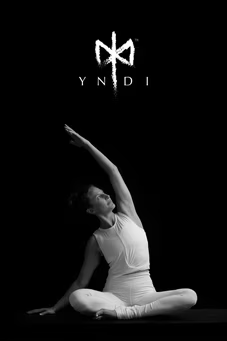
Support for PBS provided by:
Funding for ANTIQUES ROADSHOW is provided by Ancestry and American Cruise Lines. Additional funding is provided by public television viewers.


